Categories: Sockets and switches
Number of views: 10,877
Comments on the article: 1
Types and designs of dimmers for lamps
Today it is unlikely that anyone will be surprised by a dimmer for lamps. Such regulators are often found in enterprises and in everyday life, they allow you to conveniently and flexibly adjust the brightness of the light, eliminating the need for the consumer to install several light sources of different intensities in the same room.
It is very convenient to regulate the light - if in the room, for example, people not only work, but also relax. In particular, for the home living room: if you need bright light - the lamps turn on at full power, and if the family wants to relax comfortably after a working day - you just need to turn the dimmer knob - and the light will become softer, a little dimmer, it will not hurt your eyes. Such dimmers are also called dimmers (from the English word dimmer - dimmer).
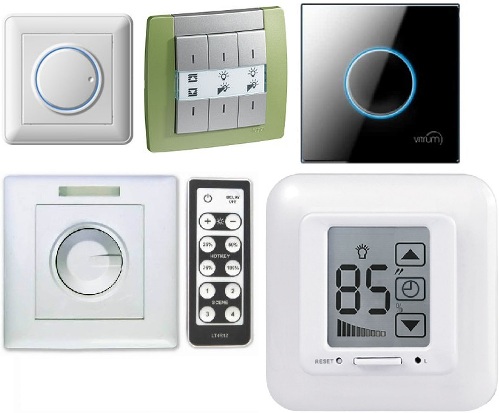
Dimmers differ in appearance, and depending on the control method, there are: with a rotary knob, with a control key (or with a sensor), with a sound sensor (popping sound), with a sensor for the remote control, and even controlled via software home automation systemaccording to a scenario predefined from the PC.
The first, most simple in design, dimmers were designed to control the brightness of the glow exclusively of incandescent lamps in AC circuits. Such dimmers are, in principle, well suited for adjusting power for any active loads that are suitable for the nominal value (incandescent lamp, soldering iron, electric heater, etc.).
The design of the simplest dimmer is based on the control of the triac in each period of the mains voltage, when the average duration of the load switching to the network is set with a variable resistor, that is, the average load current is selected that corresponds to the required glow intensity of the filament (or the desired temperature of the heating element). See here for more details. Dimmer for incandescent lamps: how it works, device and circuit
Such a simple dimmer, of course, is not suitable for an inductive load, and indeed for a non-linear load, because the form of the current here approaches pulsed, and is very different from sinusoidal.
And to work with highly non-linear loads, you need a sophisticated, more accurate and stabilized dimmer that is specifically designed, for example, to control the brightness of the glow: compact fluorescent lamps, LED lamps and ribbons, neon compositions, etc. Next, we consider different types of dimmers for order.
Simple rotary dimmer
The simplest rotary dimmer looks like a switch with a handle instead of a key. Using such a regulator, you can control the brightness of the glow of a chandelier, lamp, lamp, however, provided that the incandescent lamp is the light source in the lighting device. Just turning the knob adjusts the light according to the principle: clockwise - lighter, counterclockwise - darker.
Such dimmers are the most inexpensive, the size of a switch - mounted in the socket. The use of dimmers for incandescent lamps is not only one of the ways to save energy, but also contributes to the smooth heating of the filament, which extends the life of the lamps. Disadvantages of simple triac dimmers: overload sensitivity, narrow applicability (active loads only), creates radio interference.
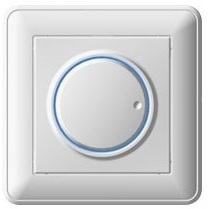

The appearance of a simple triac dimmer is the same as that of some other types of dimmers, but the simpler the dimmer, the cheaper it is and the low price, as a rule, gives a simple dimmer, and more complex dimmers have a higher price (plus the parameters indicated on the package ), despite the resemblance.
Dimmers for energy-saving (CFL) lamps
If you use a conventional compact fluorescent lamp with a simple dimmer, it will quickly fail - the interference arising from switching the triac of a simple dimmer will spoil the lamp's ballast electronics, and the lamp illumination during regulation will not change much at best, and at worst the lamp will simply flicker weakly or may not start at all.
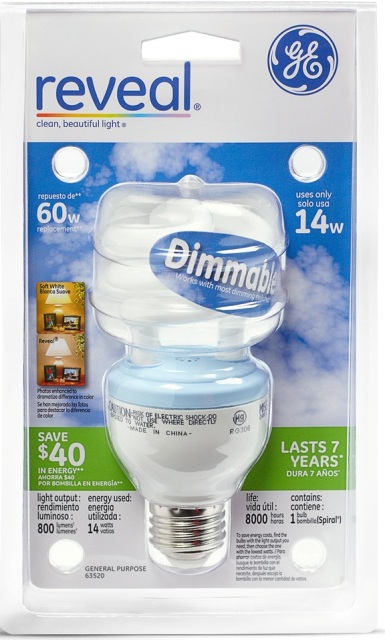
Nevertheless, there are special dimmable compact fluorescent lamps, in the electronic ballast of which there is an additional noise suppression filter and its own unit, which allows you to change the glow intensity depending on the average value of the applied voltage. On the packaging of such a lamp there is a special icon (or the inscription "dimmable"), indicating that it can be used with a conventional dimmer.
In some cases, dimmable compact fluorescent lamps require a special feedback dimmer, when the lamp ballast chip can receive a voltage signal from the dimmer from the dimmer, which must be supplied directly to the lamp.
Dimmers for LED bulbs and ribbons
The power supply for the LED strip, like the ballast of the LED lamp, is stabilized constant voltage source. With these circuits, no matter what voltage is applied to the input - if the power supply, or ballast, is started, the output will have a constant voltage of a steady value. No matter how you regulate the input voltage, dimming will not work.
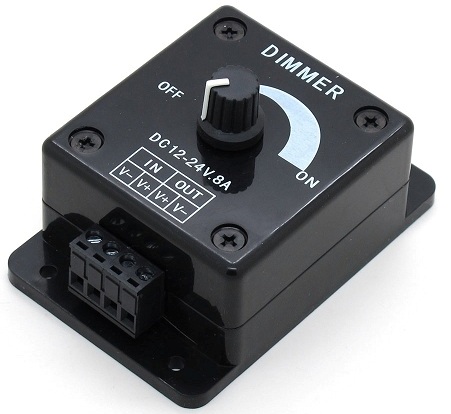
Dimmers for LED light sources themselves are adjustable voltage converters, and turn on after a stabilized power supply - between it and the lamp. Used here Pulse Width Modulation (PWM) principlewhen, by adjusting the pulse width in the high-frequency Converter, regulate the amplitude of the output voltage. If the PWM ballast is already integrated into the base of the LED lamp, nothing can be regulated.

Dimmers for LED strips are usually more expensive than conventional triac dimmers, because they contain more semiconductor components, and sometimes include complex correction circuits.
You can often find LED dimmers on the market with such additional functions as: remote control from a remote control, a timer, or even the possibility of programming and integration into a home automation system.
In appearance led dimmers, like others, there are: open and hidden wall execution, built-in or modular. The interface can be different: buttons, sensors, rotary knob, remote control.
Dimmers for neon
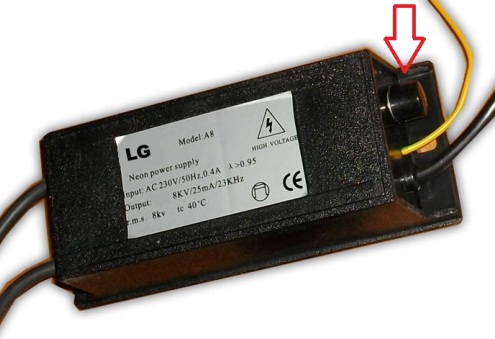
Some high-voltage high-frequency transformers for neon (the so-called electronic converters for neon) have a dimmer on the case, so that by adjusting the high voltage it is possible to control the brightness of the glow, for example, a sign. The basis of the work of such dimmers is pulse width modulation.
See also at bgv.electricianexp.com
:

